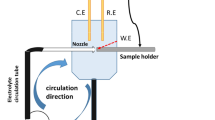The production and use of clad iron-based powder materials is a promising area of powder metallurgy that allows variation in their process and magnetic properties in wide ranges. The corrosion properties of phosphorus-clad iron powders and their interaction with biological media of the living organisms are studied. The PZhRV 3.200.26 (Ukraine), AHC 100.29 (Sweden), and PZhV 200 (Russia) iron powders with different particle sizes are clad with phosphorous by the method of thermochemical decomposition of phosphorous compounds and by the method of thermochemical synthesis in a vibrating bed. Corrosion tests of the iron powders clad with phosphorous are performed in a 3% NaCl solution. Calculations of the corrosion depth index show that the clad powders are much more resistant to corrosion in aggressive media (3–4 points according to the ISO 11130:2010 standard) than the starting powders (1 point). The low values of the corrosion depth index of phosphorus-clad powders testify that surface corrosion proceeds on powder particles. It is shown that the interaction of the starting PZhRV 3.342.28 and AHC 100.29 iron powders with human blood plasma is 5.8 and 7.2 times more intensive, respectively, than that for PZhRV 3.342.28 and AHC 100.29 powders clad with phosphorous. On the surface of iron powders, phosphorus interacts with blood plasma proteins to form a protective colloidal biocomplex, which increases substantially the resistance of clad powders in blood plasma. Thus, the cladding of iron powders with phosphorus enhances significantly their chemical stability both in human blood plasma and in air.

Similar content being viewed by others
References
G. Nord, L. O. Pennander, and A. Jack, “Loss calculations for soft magnetic composites,” in: Proc. 16th Int. Conf. Electrical Machines, Institute of Mechatronics and Information Systems, Cracow (2004), p. 6.
A. Kunevich and A. Maksimov, “Modern soft magnetic materials for power electronics,” Élektronika, No. 4, 32–35 (2008).
N. F. Kushchevskaya, “Use of ferromagnetic particles in medicine,” Powder Metall. Met. Ceram., 36, No. 11–12, 668–672 (1997).
O. A. Panasyuk, G. A. Baglyuk, V. A. Maslyuk, et al., “Cladding of iron powder to obtain soft magnetic materials with improved properties,” in: Proc. 10th Int. Conf. Hydrogen Materials Science and Chemistry of Carbon Nanomaterials (ICHMS’2007) (September 22–28, 2007, Sudak, Crimea, Ukraine) [in Russian], Kiev (2007).
Corrosion of Metals and Alloys. Alternative Testing of Salt Melt Immersion. ISO 11130:2010 [in Russian], Ukrmetrteststandart, Kiev (2010), p. 27.
S. Lomaev, A. Syugaev, S. Reshetnikov, et al., “Effect of conditions for producing nanocrystalline iron powders on their corrosion behavior in neutral media,” Zashch. Met., No. 43, 207–215 (2007).
I. T. Brakhnova, Toxicity of Metal Powders and Compounds [in Russian], Naukova Dumka, Kiev (1971), p. 224.
M. M. Shabarchina, A. I. Tsapin, A. G. Malenkov, and A. F. Vanin, “Behavior of magnetic particles of metal iron in animal bodies,” Biofizika, 35, No. 6, 985–988 (1990).
N. V. Boshitskaya, T. S. Bartnitskaya, G. N. Makarenko, et al., “Chemical stability of silicon nitride powder in biological media,” Powder Metall. Met. Ceram., 35, No. 9–10, 497–500 (1996).
V. A. Lavrenko, N. V. Boshitskaya, and G. N. Makarenko, “Mechanism of interaction of silicon nitride powders with biochemical media and their toxic effect,” in: Y. G. Gogotsi and I. V. Uvarova, Nanostructured Materials and Coatings for Biomedical and Sensor Applications, Kluwer Academic Publishers, Dordrecht, Netherlands (2003), p. 63.
Drinking Water. Methods for Determining Total Iron. GOST 4011–72 [in Russian], Gossstandart SSSR, Moscow (1972), p. 9.
N. L. Glinka and V. A. Rabinovich (ed.), General Chemistry: University Course [in Russian], 27th ed., Khimiya, Leningrad (1988), p. 704.
M. A. Bazarnova, V. T. Morozova, Yu. Yu. Levin, and N. R. Avzeeva, “Calcium and phosphorus in the human body and their disorders,” Zdor. Ukrainy, No. 86, 46–54 (2004).
K. B. Yatsimirskii, Introduction to Bioinorganic Chemistry [in Russian], Naukova Dumka, Kiev (1976), p. 140.
M. N. Hughes, Inorganic Chemistry of Biological Processes, John Wiley Publishers, New York (1973), p. 135.
Iron Powder. Photocolorimetric Method for Determination of Phosphorus. GOST 16412.2–80 [in Russian], Gossstandart SSSR, Moscow (1980), pp. 8–10.
Author information
Authors and Affiliations
Corresponding author
Additional information
Translated from Poroshkovaya Metallurgiya, Vol. 50, No. 9–10 (481), pp. 3–10, 2011.
Rights and permissions
About this article
Cite this article
Boshitska, N.V., Vlasova, O.V., Apininska, L.M. et al. Corrosion resistance of phosphorus-clad iron powders in biological and inorganic media. Powder Metall Met Ceram 50, 573–578 (2012). https://doi.org/10.1007/s11106-012-9362-0
Received:
Published:
Issue Date:
DOI: https://doi.org/10.1007/s11106-012-9362-0




